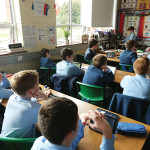Education’s new structures
 Major change is under way in the education system. Gráinne McCarry summarises the newly established Education Authority, and the region’s sectoral organisations.
Major change is under way in the education system. Gráinne McCarry summarises the newly established Education Authority, and the region’s sectoral organisations.
The Education Authority began its work on 1 April, with the task of streamlining the delivery of educational services across Northern Ireland. The region’s five education and library boards were dissolved to make way for the single authority. It took over the current roles and responsibilities of the boards, with the aim of being more cost-efficient. Over 39,000 people in teaching and non-teaching roles are employed by the authority.
The Education Authority board has been appointed, comprising 20 members and one Chairperson, Sharon O’Connor. She was previously Chief Executive of Derry City Council.
Eight board members were nominated by the four largest political parties according to the d’Hondt system – three each for the DUP and Sinn Féin, and one each for the SDLP and UUP.
Four members of the board represent controlled schools and four represent Catholic maintained schools. Integrated, Irish medium, voluntary grammar and controlled grammar schools each have one member.
The end goal is that all educational policies will be delivered in the same way throughout Northern Ireland regardless of where a child lives or the type of school attended.
The region’s sectoral organisations are as follows:
• Comhairle na Gaelscolaíochta. The representative body for Irish-medium education (IME) was established by the Department of Education in 2000 to promote, facilitate and encourage IME. The organisation also works to make education of this kind available in locations where there is a demand from parents.
• Council for Catholic Maintained Schools. Established as a statutory body under the 1989 Education Reform (Northern Ireland) Order, it represents Catholic maintained schools and their trustees and governors on issues such as effective management and control of schools. It is the second largest employer of teachers in Northern Ireland, employing 6,000 teachers.
• Integrated Education Fund. A charitable trust which relies solely on donations. Established in 1992 due to a growing demand from parents and pupils for integrated education, the trust raises money to alleviate the shortfall between government funding and what is required to keep the schools operational.
• Iontaobhas na Gaelscolaíochta. Created in 2001 as a result of the Good Friday Agreement’s commitment to develop a trust fund for Irish-medium education, its aim is to provide a financial foundation, through government assistance and from public and corporate donations, for the development and support of the sector.
• Northern Ireland Council for Integrated Education. NICIE began in 1987 as a charity formed to co-ordinate the development of integrated education and to support parents’ groups in the opening of new schools. While the council no longer provides funds to open new schools, it continues to support parents, and also schools wishing to change their status.
• Controlled Schools Sectoral Council. Currently at working group stage, the council will provide a voice for controlled schools and will include the main Protestant churches (transferors). The council will work with these schools to develop and maintain a collective ethos and also with the Education Authority to raise educational standards. It will also participate in the planning of the schools estate.
•· • Governing Bodies Association. The GBA represents the interests of the region’s voluntary grammar schools which have more autonomy in governance and employment of staff than schools in other sectors. Their ethos and aims reflect those set out in the schools’ foundation documents.
· Governing Bodies Association. The GBA represents the interests of the region’s voluntary grammar schools which have more autonomy in governance and employment of staff than schools in other sectors. Their ethos and aims reflect those set out in the schools’ foundation documents.





